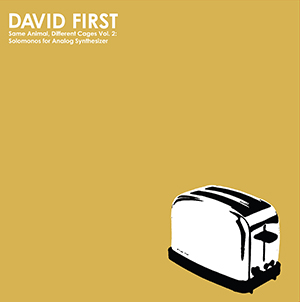 For the second part of the quadrilogy, the cage that composer David First decided to lock himself into is perhaps the most sonically diverse and flexible of the chosen cages: the venerable Korg MS-20 synthesizer. Compared to the previous work using an acoustic guitar, and the future two involving blues harp and sitar, the massive array of knobs and options almost seem not limiting enough, conceptually speaking. As a whole, First adheres to his staunchly ascetic approach to composition and delivers an appropriately focused meditation on the instrument.
For the second part of the quadrilogy, the cage that composer David First decided to lock himself into is perhaps the most sonically diverse and flexible of the chosen cages: the venerable Korg MS-20 synthesizer. Compared to the previous work using an acoustic guitar, and the future two involving blues harp and sitar, the massive array of knobs and options almost seem not limiting enough, conceptually speaking. As a whole, First adheres to his staunchly ascetic approach to composition and delivers an appropriately focused meditation on the instrument.
The MS-20 is an excellent choice from both a conceptual and sonic standpoint:it has more flexibility and depth than the earlier analog units, but its semi-modular construction means it cannot go too crazy compared to true modular synthesizers.It also makes for an instrument that is well suited for hands-on improvisation, perhaps even more so than for conventional playing.There is a reason that everyone from indie hipsters to politically questionable European power electronic bands has favored this thing for a number years, and extra kudos to First for using the more recent mini reissue.
Even with the added flexibility of the instrument, First keeps things such as post-production and effects to a minimum, with most of the pieces being recorded simply in mono, and a few having only subtle accents added in the form of post production.The first side opens up with the sputtering electronics of "Dronemod2/ESP," locking into a rigid structure of repetition.First keeps the variations to a minimum to focus on the core sound, with only subtle changes being noticeable that may be either subtle tweaking of LFO effects on the filter or the generally unstable nature of analog electronics.
"S&H" is more commanding, patched into a 1980s video game like loop.The insistent pulse never changes for the piece's lengthy 12 minute duration, but his tweaking of the pitch knobs and filter effects makes it an overall diverse and dynamic experience.For the opener of the second side, "Bassdronemod", First eschews a more rhythmic approach to instead stay as a brittle, sustained bit of electronic noise.The composition ends up becoming crunchier and crunchier, and as a result it is one of the harshest and most intentionally abrasive pieces here.
For "Dronemod2," First goes back to a raygun like traditional synth pulse that never ceases, but for what seems so initially basic ends up being far more nuanced and expansive.By the end, the sound locks into an engine like chug that sounds more like a lawnmower than most synthesizers are able to.Comparably, "Pulse Filtering" is overall looser and more erratic, with a tremolo like dynamic that helps propel the weird shifting pitches.The final piece, "S&H-Switch-MW" is First opting for the most overly harsh noise sounding work here.With wet, sweeping noises scattering atop an unrelenting rhythmic throb, it could almost be a lost work from an Astro or CCCC album.The sci-fi tinged spacey depth, strong variation and diversity in sound comes together as a hyperactive, strongly varied recording that stands out as a high point on a very strong record overall.
Even with the diverse array of noises and sound that the MS-20 is capable of, David First keeps himself in check with these performances, which ensures that Solomonos for Analog Synthesizer stays within his self-imposed performance and compositional guidelines.I am personally expecting that this will end up being my favorite in the series, given my own affinity for the model of synthesizer, but I imagine that it will be an important piece of the overall series, even if it stands so distinctly on its own.
samples:
 
Read More

